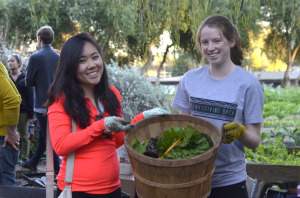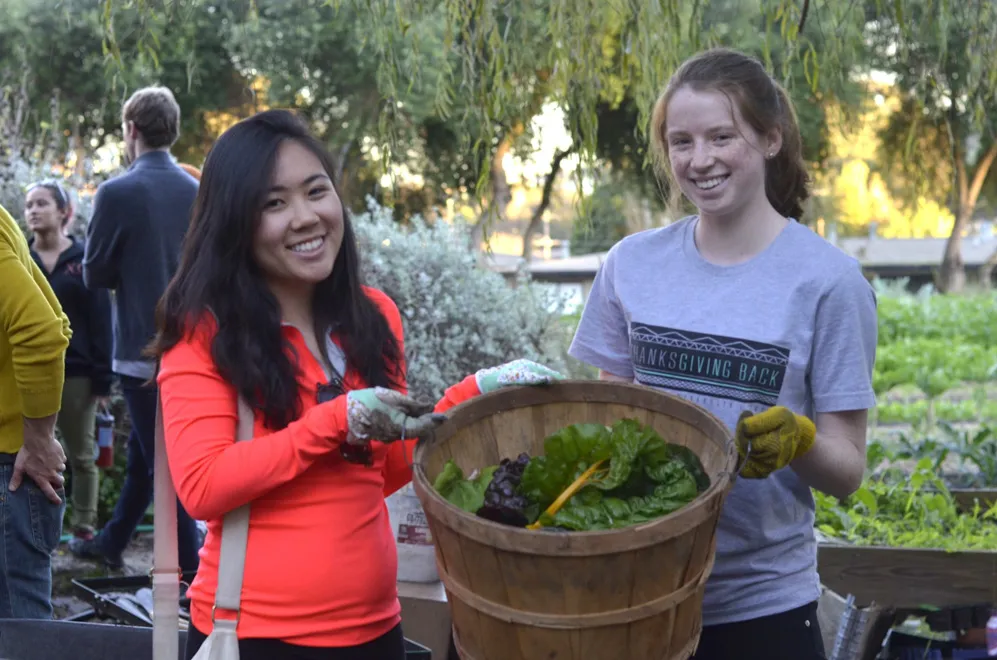
While some Stanford students were at home feasting on turkey and watching TV in their pajamas, students on this year’s ThanksGiving Back (TGB) trips were participating in public service opportunities around the Bay Area.
TGB is the sister of Alternative Spring Break (ASB) and features experiential learning projects throughout the week. TGB founder Rachel Kelley ‘13 said in 2012, the inaugural year of TGB, that the program began in response to the popularity of ASB.
In its first year, the program received 94 applications for about half that number of spots, and it has remained popular since then. TGB is sponsored by the Haas Center for Public Service.
TGB coordinator Ray Chen ‘16 said that compared to ASB trips, TGB trips are shorter both in class time and in trip time. While participants of ASBs have to take a 10-week, one unit class prior to their trips, TGB participants only attend three workshops. TGB trips are slightly shorter in duration, ending before Thanksgiving to allow participants to return home for the holiday.
The contents of the TGB trips are similar to ASB, but the itinerary and goals are restricted by the shorter time frame, Chen said. In contrast to ASB programs, which span the country, all three TGB trips take place within a few hours of campus.
Groups stay with Stanford alumni, community organizations and other low budget options. The fee for the program is $90, and financial aid is available.
TGB was created to reach students who did not have the ability to commit to the quarter-long directed reading course and entire spring break trip of ASB, Rachel Kelley, one of the founders, said.
“We also wanted to reach out to students who were interested in public service and service-learning, but perhaps had never before had the chance to participate,” Kelley said.
Founders of the TGB program also hoped that a service-immersion experience during fall quarter would be a great way to get students involved with public service and activism earlier in the school year, whether through new friendships built through TGB or new connections to Stanford student groups or Bay Area public service organizations.
“We hoped that this earlier introduction could make a meaningful impact on how students chose to spend the rest of their school year and beyond,” Kelley said.
This year’s topics included three subjects. “Edtech: How Silicon Valley is Shaping the Future of Education” examined perceived inequalities in the American education system and challenges threatening the future of the American school system.
The group explored what Silicon Valley is doing, and what Stanford students can do to respond to some of these issues. Participants visited major edtech (education technology) companies including Udacity — a widely used online service that offers classes, especially in Computer Science.
They also made stops at schools, spoke with venture capitalists and did a project with a local middle school class on improving the classroom experience.
On what participant Diego Hernandez ’17 described as the most memorable day, the group visited the Burlingame Intermediate School and did an activity with middle schoolers on how to best use technology in the classroom.
“My group proposed a TED-style event for students to share their passions with other students…[t]his was really interesting to me because it showed me that students could become much more involved in their own education if the right kind of structure was in place,” Hernandez said.
Leaders Kai Feng ‘17 and Ngoc Bui ’17 expressed passion about public service in education.
“Education is critical to social development, and technology is changing the way we are receiving it,” Feng said.
Bui, who cited her TGB experience as the highlight of her freshman year, said, “I believe technology has the potential to finally bring about innovation in the classroom. Our teaching methods have been stagnant and inefficient for far too many years. I can see edtech serving as the catalyst for transforming learning in schools, which is extremely exciting.”
The second trip was titled, “Medicine in Science and Society.” It introduced participants to service opportunities in the Bay Area, with the goal of helping them find the intersection of medicine and service that most interests them.
“Medicine involves the very two aspects that TGB champions: service and learning. It’s a never ending progression of both, which is why this topic fit so well with the TGB mission,” said leader Maheetha Bharadwaj ’16.
The curriculum included four areas of medicine: research, clinical, palliative and integrative therapy. Students heard from experts in each of these fields, and worked with patients in service settings.
Bharadwaj said her goal for participants was “to convey to them that medicine isn’t just about prescribing drugs to patients: what makes medicine meaningful is when you put a part of yourself into your work.”
The most meaningful part of the trip for the group, Bharadwaj said, was their visit to the Pomeroy Center, where the students led an art therapy workshop together for patients with severe brain damage.
The last trip centered around “Urban Food Solutions: Strategies for Sustainable Food.” The group focused on sustainable food in the Bay Area, including volunteering at “green” soup kitchens and organic city gardens across Silicon Valley.
“As avid cooks and lovers of food, and as lifelong Silicon Valley residents, we are both especially aware of the food choices our home region offers,” wrote leaders Minna Xiao ’16 and Shubha Raghvendra ’16 in the course description. Xiao is also a writer for the Stanford Daily.
Megan Lu ’15 was glad that she could participate in TGB.
“I’m from New York, so I’m usually someone’s houseguest over Thanksgiving. Spending the first half of the week on TGB means I can do something good for the community,” Lu said.
Contact Katie Kramon at ckramon ‘at’ stanford.edu.
